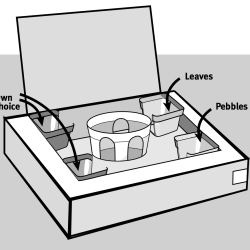Source Institutions
Source Institutions
Add to list Go to activity
Activity link broken? See if it's at the internet archive

In this activity, learners make their own bug boxes and test the habitat preference of selected "minibeasts" (bugs). Activity is broken down into two sessions because the boxes are fixed more securely when the glue is given sufficient time to dry. It is also recommended that learners collect habitat materials at the start of the second session to ensure that they are fresh. Use this to discuss species classification and habitats. For safety information regarding bug collection, see the last page of the introduction to the Minibeast Discovery Pack (see related resource).
- Under 5 minutes
- 2 to 4 hours
- $5 - $10 per student
- Ages 6 - 14
- Activity, Experiment/Lab Activity, Lesson/Lesson Plan
- English
Quick Guide
Materials List (per student)
- 1 medium sized cereal box (A 750 g box is ideal but smaller 500 g boxes can be used effectively)
- 1 large round plastic tub
- 5 small square plastic tubs - all the same size (Square tubs fit neatly into the corners of the bug box but round tubs may also be used, so long as they are all of the same size to maintain fairness)
- A suitable ‘child-safe’ glue
- Sticky tape
- Scissors (A craft knife may also be useful - but learners should always be supervised when using the knife)
- Magnifying glass (optional; to help the learners to draw their minibeast)
- Perforated polythene or fine wire gauze to cover bug boxes if they are to be left unattended (Generally it is recommended that observation and recording are carried out in one continuous session)
- Discovery sheets 2a and 2b
Subjects
-
Life Sciences
-
Diversity of Life
- Animals
-
Ecology
- Ecosystems
-
Diversity of Life
-
The Nature of Science
-
The Scientific Process
- Asking Questions
- Conducting Investigations
- Gathering Data
- Formulating Explanations
- Communicating Results
-
The Scientific Process
Informal Categories
- Animals
- Arts and Crafts
- Nature and Environment
- Outdoor Activity
Audience
To use this activity, learners need to:
- see
- read
- be mobile
- touch
Learning styles supported:
- Involves hands-on or lab activities
Other
Components that are part of this resource:
This resource is part of:
Access Rights:
- Free access
By:
Rights:
- All rights reserved, Biotechnology and Biological Sciences Research Council,
